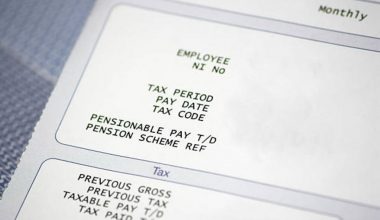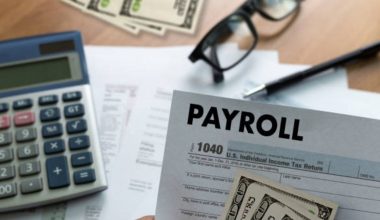This is a simplified gross profit guide that covers every detail about the topic, ranging from its formula to how to calculate with examples and comparisons.
Definition
Gross profit, in plain terms, is the profit a company makes after deducting the costs of producing and selling its products, or the costs of providing its services. Basically, the cost of goods sold (COGS) is subtracted from revenue to calculate gross profit. This appears on a company’s income statement. Gross profit is also known as gross income or sales profit.
What is the Formula for Gross Profit?
G.P=Revenue−Cost of Goods Sold
Gross Profit formula & How to Calculate
What You Can Learn From Gross Profit
The efficiency of a company’s labor and supplies in creating goods or services is measured by gross profit. The metric focuses on variable costs, which are costs that change in response to output levels, such as:
- Materials
- Salespeople’s commissions
- Direct labor, assuming it is hourly or otherwise dependent on output levels
- Purchases made with a credit card, which are subject to a fee.
- Equipment, maybe including depreciation based on usage
- Utilities for the manufacturing facility
- Shipping
Meanwhile, gross profit does not include fixed costs, as the term is commonly understood (that is, costs that must be paid regardless of the level of output).
As we can see from the COGS categories stated above, gross profit is primarily made up of variable costs, or costs that vary based on production output. Fixed costs, which are costs incurred regardless of production output, are typically not included in gross profit. Salary for the corporate office, rent, and insurance are examples of fixed costs.
Some companies, however, may assign a portion of their fixed costs used in production to each unit produced, a practice known as absorption costing. Let’s imagine a manufacturing factory produced 5,000 cars in a quarter and paid $15,000 in rent. Each automobile produced would be assigned $3 in costs under absorption costing.
However, for absorption costing, which is required for external reporting under Generally Accepted Accounting Principles, a portion of the fixed cost is assigned to each unit of production.
Read Also: What are the Generally Accepted Accounting Principles: All You Need
For example, if a manufacturer produces 10,000 widgets in a particular period and pays $30,000 in rent for the facility, absorption costing would assign a $3 cost to each widget.
Operating profit should not be confused with gross profit either. By subtracting operational expenses from gross profit, operating profit is derived.
Gross Profit Margin vs. Gross Profit
Although the phrases are similar (and are sometimes used interchangeably), gross profit and gross profit margin are not the same things. The gross profit margin is expressed as a percentage while the gross profit is expressed as a monetary amount. The gross profit margin formula is as follows:
Gross Margin= Revenue−Cost of Goods Sold/ Revenue
Gross Profit Margin formula & How to Calculate
The gross profit margin is often calculated using gross profit. This metric is useful for comparing the efficiency of a company’s production over time. Comparing gross profits from year to year or quarter to quarter can be deceiving because gross earnings might climb while gross margins shrink, which is a concerning pattern that could find a company in hot water.
How to Use Gross Profit as an Example
Using Company XYZ’s income statement as an example, here’s how to calculate gross profit and gross profit margin.
| Revenues | (in USD millions) |
| Automotive | 141,546 |
| Financial services | 10,253 |
| Other | 1 |
| Total revenues | 151,800 |
| Costs and expenses | |
| Automotive cost of sales | 126,584 |
| Selling, administrative, and other expenses | 12,196 |
| Financial Services interest, operating, and other expenses | 8,904 |
| Total costs and expenses | 147,684 |
So to figure out the gross profit, add the cost of goods sold (COGS), which totals $126,584. And because selling, administrative, and other expenses are mostly fixed costs, we do not include them.
The gross profit is calculated by subtracting the cost of goods sold from revenues, yielding $151,800 – $126,584 = $25,216 million.
We divide gross profit by total revenues to get the gross profit margin, which is
$25,216 / $151,800 = 16.61 percent.
This compares favorably to the industry average of around 14%, indicating that XYZ is more efficient than its competitors.
The Limitations of Using Gross Profit
For the most part, financial data services’ standardized income statements may produce slightly different gross profits. Gross earnings are readily displayed as a single line item on these accounts. But they are only available for public corporations.
Investors looking at the financial statements of private companies should be aware of the cost and expense items on a non-standardized balance sheet that may or may not be factored into when they calculate gross profit calculations.
Gross Profit vs. Net Income
Gross profit and net income are two key profitability indicators for any business. After production costs have been deducted from revenue, gross profit is the remaining income or profit.
The amount of money earned from the sale of a company's goods and services is referred to as revenue.
Investors often use gross profit to figure out how much money a company makes from the production and sale of its goods and services. The term “gross profit” is sometimes interchanged with “gross income.”
Net income, on the other hand, is the profit left over after all expenses and costs have been deducted from revenue. Investors use net income or net profit to determine a company’s total profitability, which shows how well it has been managed.
Understanding the distinctions between gross profit and net income can assist investors in determining if a company is profitable and, if not, plus where it is losing money.
Before we go any further, let’s bring you up the speed with regards to certain terms you would come across down the line.
Revenue
The total amount of money earned from sales for a given period, such as a quarter, is referred to as revenue. Because it may include discounts and deductions from returned or damaged merchandise, revenue is sometimes referred to as net sales.
For example, net sales are often reported as revenue in the retail industry. The value of products returned by customers is deducted from the overall income. Furthermore, revenue is often referred to as the “top line” figure because it appears at the top of the income statement.
Cost of Goods Sold COGS)
The direct costs of producing a company’s goods are referred to as the cost of goods sold. The following items are often included in COGS:
- Direct Materials which include raw materials and inventory
- Wages for production workers, for example, direct labor.
- Production-related equipment costs
- Repair costs for equipment
- Utilities for manufacturing plants
- Shipping costs
Net Income
A company’s profit during the accounting period is referred to as net income. In other words, net income includes all of a company’s costs and expenses, which are deducted from revenue. Net income is commonly referred to as the bottom line because of its location at the bottom of the income statement.
Although a company’s income statement might include a variety of things, depending on the industry, net income is often calculated by deducting the following expenses from revenue:
- Expenses of operations
- Interest on loans and debt
- Overhead for example; selling, general and administrative expenses
- Taxes on earnings
Net income often includes additional sources of income. Companies, for example, often invest their capital in short-term assets, which is called income. Profits from the sale of assets are also counted as income.
How to Calculate Net Income
As previously stated, net income is calculated by deducting all expenses and costs from revenue and adding income from other sources. A firm may have several sources of income in addition to revenue and various forms of expenses, depending on the industry. On the income statement, some of the income sources or costs could be listed as separate line items.
A company in the manufacturing industry, for example, would likely have COGS mentioned, whereas a company in the service industry would not have COGS and instead put its costs under operational expenditures.
The following is a general formula for calculating net income:
Net Income= Total Revenue – Total Expenses
A more detailed formula would look like this:
Net Income = G.P — Operating Expenses — Other Business Expenses — Taxes — Interest on Debt + Other Income
Key Differences
The ability of a corporation to make a profit while managing its production and labor costs is measured by gross profit. As a result, by examining sales, production costs, labor costs, and productivity, it is a key statistic in evaluating whether a company’s earnings are increasing or declining. The gross profit for that period will be lower if a company reports an increase in revenue that is more than offset by an increase in production costs, such as labor.
For example, if a company hires too few production workers for its peak season, current employees will be forced to work longer hours. Higher labor expenses and a decrease in gross profit would be the result. However, using gross profit as a criterion for total profitability is flawed since it excludes all of the other costs associated with running a successful business.
Net income, on the other hand, is the profit earned from all areas of a company’s operations. As a result, net income is more inclusive than gross profit and can reveal the success of the management team.
A firm might, for example, boost its gross profit while also mismanaging its debt by borrowing too much. Despite the company’s excellent sales and production efforts, the higher interest expense for repaying the debt could result in a loss in net income.
Gross Profit and Net Income Limitations
Because gross profit may not apply to all companies and industries, it has several restrictions. A services company, for example, is unlikely to have production costs or costs of goods sold. Although net income is the most comprehensive measure of a company’s profit, it is not without flaws and can be misleading. If a corporation sold a building, for example, the proceeds from the sale would boost net income for that period. Investors that focus solely on net income may misunderstand the company’s profitability as an increase in product and service sales.
Operating profit, gross profit, and net profit are all terms used to describe how much money a company makes.
It’s crucial to remember that gross profit and net income are just two of the many profitability indicators that may be used to assess a company’s performance. Operating profit, for example, is a company’s profit before interest and taxes are subtracted, which is why it’s called EBIT (earnings before interest and taxes). However, the company’s running expenses are removed from gross profit when computing operating profit. Overhead costs, such as salary from the corporate office, are included in operating expenses. Operating profit, like gross profit, is calculated by taking a slice or section of a company’s income statement, whereas net income comprises all income statement components.
If a company’s gross profit is positive for the quarter, it doesn’t guarantee it’s profitable. For example, if a corporation has too much debt, it will have significant interest expenses, which will wipe out the gross profit, resulting in a net loss (or negative net income).
Example of Gross Profit vs. Net Income
J.C. Penney, the world’s largest store, is one of many companies that have struggled financially in recent years. A comparison of the company’s gross profit and net income in 2017 is shown below, along with a forecast for 2020.
2017
On their 10K annual statement for 2017, J.C. Penney disclosed the following income statement:
- $12.50 billion in revenue and net sales.
- Gross Profit: $4.33 billion (total revenue of $12.50 billion minus cost of goods sold of $8.17 billion).
- A $116 million loss in net income.
After deducting the remaining expenses, such as selling, general, and administrative (SG&A) charges, as well as the interest cost of its debt, J.C. Penney really lost $116 million that year. This real-world example explains why analyzing a company’s financial accounts using numerous measures is crucial for accurately determining whether the company is functioning well or losing money.
2020
J.C. Penney has struggled to stay afloat. In Q3 2020, the company recorded total revenue of $1.758 billion and a cost of goods sold of $1.178 billion, resulting in a gross profit of $580 million.
However, the corporation lost $3368 million in net income. Despite the fact that many shops were hit by the recession that followed the coronavirus outbreak in 2020, J.C. Penney recorded a net loss of $93 million in the same quarter in 2019.
Regardless of having generated sales and a positive gross profit, J.C. Penney demonstrates how costs and interest on debt can wipe out gross profit and result in a net loss or a negative net income figure.
How to Calculate Gross Profit
As demonstrated below, gross profit is determined by subtracting revenue or net sales from a company’s cost of goods sold:
Gross Margin= Revenue−Cost of Goods Sold/ Revenue
Gross Profit Margin formula & How to Calculate
The income statement shows gross profit and net profit. And because all expenses and costs are subtracted from revenue, net income is found at the bottom of the income statement.
Example
Assume you own a beachside stand where you sell snorkel gear. The only cost directly related to making a sale is the cost of the snorkel gear you’re selling to those who arrive at the beach unprepared.
You will have made $200 in sales if you price your snorkel sets at $20 each and sell 10 sets before hitting the surf at noon.
$20 per snorkel set sold multiplied by ten snorkel sets sold equals $200 in sales.
However, you must pay for the snorkel sets that you sold.
You probably paid in full before your supplier shipped them to you, but you’ll need to replace your stock if you don’t have anything to sell or your beach stand will close. Let’s say you paid $5 each for your snorkel sets. As a result, the 10 snorkel sets you sold cost $50.
$50 in cost of goods = $5 per snorkel set x 10 snorkel sets purchased for resale
This equates to a $150 gross profit:
Sales of $200 in snorkel sets minus $50 paid to the snorkel set supplier equal a gross profit of $150.
This $150 is then utilized to keep your beach stand running, advertise at the tiki house down the beach, and so on.
The money you have available to run your business after paying for the items or services that allow you to make sales in the first place is known as gross profit.
How to Calculate Gross Profit Margin
Your gross profit margin can also be calculated using the gross profit formula. The gross profit margin is a fantastic tool to track the efficiency of your company’s output over time. The gross profit margin is a percentage, whereas gross profit is a monetary number.
You can calculate gross profit margin with the formula below:
Gross profit margin = revenue less cost of goods sold / revenue
Because gross profit might climb while gross profit margins shrink, calculating gross profit without taking the gross profit margin into account can be misleading.
How to Boost Your Gross Profit
What do you do with gross profit now that you know how to calculate it using its formula? You want to try to maximize your profit like you do with any business.
Increased gross profit directly affects your bottom line since gross profit is the difference between total sales and the cost of what you’re selling.
A Sales-Driven Company
A lot of things can be done to boost gross profit in every business that sells a product. To begin, cutting the cost of items can help you increase your profits. When making substantial purchases in bulk, many providers will give you a discount. Others will give you a seasonal discount if you have enough space to keep items until you need them.
Assume you find a new supplier who will offer you snorkel sets for $4.50 rather than $5. Those same ten snorkel sets are now $45, resulting in a G.P of $155. That’s an extra $5 you may invest towards improving your beach stand, hiring an employee to help you catch the waves faster, or putting it straight into your business bank account.
Anything you can do to enhance efficiency or cut costs immediately affects your gross profit, which means you may make more money without increasing sales.
In a competitive market when other firms are selling the same product or service as you, increasing gross profit is crucial. There are essentially only two methods to improve your top line in a long-term sustainable way: either raise your product prices or expand your sales volume.
None of the aforementioned choices may be available to you in a competitive market. This emphasizes the importance of optimizing your gross earnings. Although you may not be able to significantly alter your top line, maximizing your G.P may provide you with a significant competitive edge.
A Service-based Company
If you run a service-based company rather than a retail store, raising your gross profit means you may make more money with the same amount of work.
This can be accomplished through the use of automation, the streamlining of systems, or the negotiation of cost with subcontractors that assist you in providing your service. Subcontractors frequently offer better rates if you pay in advance for a substantial chunk of time, and some will even give you a discount if you sign up for an automatic payment plan.
The more your service-based business’s efficiency, the higher the gross profit you can expect. Increasing the cost of service will assist your bottom line and boost your gross profit, as long as it does not alienate your customer base.
What Is the Meaning of Gross Profit?
Gross profit, in plain terms, is the profit a company makes after deducting the costs of producing and selling its products, or the costs of providing its services. Basically, the cost of goods sold (COGS) is subtracted from revenue to calculate gross profit, which appears on a company’s income statement. Gross profit is also known as gross income or sales profit.
How Do I Calculate Gross Profit?
You calculate gross profit by using the formula; Gross Profit=Revenue−Cost of Goods Sold
What Is the Profit Formula?
Almost like the gross profit, you can calculate profit using the formula; Total Revenue – Total Expenses = Profit
What Are Different Types of Profit?
Profit is measured in three ways. There are three of them:
- gross profit.
- operating profit.
- net profit.
What Is Net Income vs Gross Profit?
Gross profit minus all other expenses and costs, as well as any other income and revenue sources not included in gross income, is net income. Interest on debt, taxes, and operating expenses or overhead costs are a few of the costs deducted from gross income to calculate net income.
Final Thoughts
Those new to financial statement analysis frequently acquire confidence by learning one metric at a time, just like those new to diving learn to snorkel just off the coast. You now understand how to calculate gross profit with its formula and why it is critical to do so.
After you’ve mastered the gross profit formula and learned how to apply it to your firm, you can go on to learning about operating revenue and net profit.
All three computations will reveal new information about your company, and you’ll be able to read your profit and loss statement like a pro in no time.







1 comment
Thanks for such an informative article